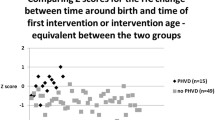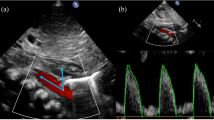Abstract
Background
Transient periventricular echodensities (PVE) in preterm infants affect neurodevelopmental outcome.
Objective
To correlate the duration and grading of PVE with neurodevelopmental outcome.
Materials and methods
A retrospective, single-centre cohort study of infants with PVE diagnosed by ultrasonography from 1995 to 2000 with blinded grading and recognition of duration of PVE.
Results
A total of 72 infants (median gestational age 32 weeks, median birth weight 1,668 g) were diagnosed as having PVE. Minor neurological abnormalities were diagnosed in seven (10%), cerebral palsy in six (8%), developmental delay in seven (10%), and mild mental retardation in two (3%) of the infants. Differences regarding adverse outcome were not significant between infants with severity grade 1 compared to severity grade 2 (16% and 22%, respectively). There was a significant increase in adverse neurodevelopmental outcome with increasing duration of PVE. Of 33 infants with duration of PVE <7 days, 1 (3%) had an adverse neurodevelopmental outcome, compared to 6 (24%) of 25 infants with a duration of PVE of 7–14 days, and 6 (43%) of 14 infants with a duration of PVE >14 days (P<0.002, RR 7.920, 95% CI 1.017–61.661; P<0.001, RR 14.143, 95% CI 1.871–106.895, respectively).
Conclusion
The duration, but not the grading, of transient PVE was significantly correlated with neurodevelopmental outcome.


Similar content being viewed by others
References
Graham M, Levene MI, Trounce JQ, et al (1987) Prediction of cerebral palsy in very low birth weight infants: prospective ultrasound study. Lancet ii:593–596
Pidcock FS, Graziani LJ, Stanley C, et al (1990) Neurosonographic features of periventricular echodensities associated with cerebral palsy in preterm infants. J Pediatr 116:417–422
Fazzi E, Orcesi S, Caffi L, et al (1994) Neurodevelopmental outcome in preterm infants with periventricular leukomalacia. Neuropediatrics 25:134–139
Volpe JJ (1997) Brain injury in the premature infant. Neuropathology, clinical aspects, pathogenesis, and prevention. Clin Perinatol 24:567–587
De Vries LS, Regev R, Pennock JM, et al (1988) Ultrasound evolution and later outcome of infants with periventricular densities. Early Hum Dev 16:225–233
De Vries LS, Eken P, Dubowitz LM (1992) The spectrum of leukomalacia using cranial ultrasound. Behav Brain Res 49:1–6
Di Pietro MA, Brody BA, Teele RL (1986) Peritrigonal echogenic “blush” on cranial sonography: pathologic correlates. AJR 146:1067–1072
Trounce JQ, Fagan D, Levene MI (1986) Intraventricular haemorrhage and periventricular leucomalacia: ultrasound and autopsy correlation. Arch Dis Child 61:1203–1207
Grant EG, Schellinger D, Richardson JD, et al (1983) Echogenic periventricular halo: normal sonographic finding or neonatal cerebral hemorrhage. AJR 140:793–796
Trounce JQ, Rutter N, Levene MI (1986) Periventricular leucomalacia and intraventricular haemorrhage in the preterm neonate. Arch Dis Child 61:1196–1202
Appleton RE, Lee RE, Hey EN (1990) Neurodevelopmental outcome of transient neonatal intracerebral echodensities. Arch Dis Child 65:27–29
Jongmans M, Henderson S, De Vries L, et al (1993) Duration of periventricular densities in preterm infants and neurological outcome at 6 years of age. Arch Dis Child 69:9–13
Ringelberg J, Van de Bor M (1993) Outcome of transient periventricular echodensities in preterm infants. Neuropediatrics 24:269–273
Bos AF, Martijn A, Okken A, et al (1998) Quality of general movements in preterm infants with transient periventricular echodensities. Acta Paediatr 87:328–335
Van Wezel-Meijler G, Van der Knaap MS, Oosting J, et al (1999) Predictive value of neonatal MRI as compared to ultrasound in premature infants with mild periventricular white matter changes. Neuropediatrics 30:231–238
Kreuzer C, Urlesberger B, Maurer U, et al (2003) Transient periventricular echodensities (TPE) in preterm infants under 1500 grams: an analysis of the outcome of the last 10 years. Klin Paediatr 215:252–256
Papile L, Burstein J, Burstein R, et al (1978) Incidence and evolution of subependymal and intraventricular hemorrhage: a study of infants with birthweight less than 1500 g. J Pediatr 92:529–534
Griffith A (1970) The abilities of babies. University of London Press, London
Kaufman AS, Kaufman NL (1991) Kaufman assessment battery for children (German version). Swets Zeitlinger, Amsterdam Lisse Frankfurt am Main
Amiel-Tison C, Stewart AL (1989) Follow-up studies in the first five years of life: a pervasive assessment of neurological function. Arch Dis Child 64:496–502
Touwen BC (1976) Neurological development in infancy. Heinemann Medical Books, London
Levene M, Dowling S, Graham M, et al (1992) Impaired motor function (clumsiness) in 5 year old children: correlation with neonatal ultrasound scans. Arch Dis Child 67:687–690
Nelson KB, Ellenberg JH (1981) Apgar scores as predictors of chronic neurologic disability. Pediatrics 68:36–44
Stewart AL, Reynolds EO, Hope PL, et al (1987) Probability of neurodevelopmental disorders estimated from ultrasound appearance of brains of very preterm infants. Dev Med Child Neurol 29:3–11
Lai FF, Tsou KY (1999) Transient periventricular echodensities and developmental outcome in preterm infants. Pediatr Neurol 21:797–801
Resch B, Jammernegg A, Vollaard E, et al (2004) Preterm twin gestation and cystic periventricular leucomalacia. Arch Dis Child Fetal Neonatal Ed 89:F315–F320
Enriquez G, Correa F, Lucaya J, et al (2003) Potential pitfalls in cranial sonography. Pediatr Radiol 33:110–117
Author information
Authors and Affiliations
Corresponding author
Rights and permissions
About this article
Cite this article
Resch, B., Jammernegg, A., Perl, E. et al. Correlation of grading and duration of periventricular echodensities with neurodevelopmental outcome in preterm infants. Pediatr Radiol 36, 810–815 (2006). https://doi.org/10.1007/s00247-006-0178-2
Received:
Revised:
Accepted:
Published:
Issue Date:
DOI: https://doi.org/10.1007/s00247-006-0178-2




